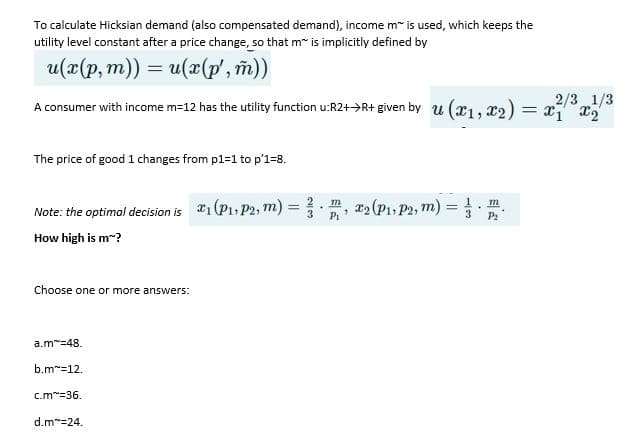To calculate Hicksian demand (also compensated demand), income m" is used, which keeps the utility level constant after a price change, so that m" is implicitly defined by u(x(p, m)) = u(x(p', m)) 2/3 1/3 A consumer with income m=12 has the utility function u:R2+>R+ given by u (x1, æ2) = x°x, %3D The price of good 1 changes from p1=1 to p'1=8. Note: the optimal decision is 1 (P1, P2, m) = 2 3 m, a2 (P1, P2, m) = : How high is m"? Choose one or more answers: a.m"=48. b.m"=12. c.m"=36. d.m"=24.
To calculate Hicksian demand (also compensated demand), income m" is used, which keeps the utility level constant after a price change, so that m" is implicitly defined by u(x(p, m)) = u(x(p', m)) 2/3 1/3 A consumer with income m=12 has the utility function u:R2+>R+ given by u (x1, æ2) = x°x, %3D The price of good 1 changes from p1=1 to p'1=8. Note: the optimal decision is 1 (P1, P2, m) = 2 3 m, a2 (P1, P2, m) = : How high is m"? Choose one or more answers: a.m"=48. b.m"=12. c.m"=36. d.m"=24.
Chapter4: Utility Maximization And Choice
Section: Chapter Questions
Problem 4.14P
Related questions
Question

Transcribed Image Text:To calculate Hicksian demand (also compensated demand), income m" is used, which keeps the
utility level constant after a price change, so that m" is implicitly defined by
u(x(p, m)) = u(x(p', m))
%3D
2/3 1/3
A consumer with income m=12 has the utility function u:R2+>R+ given by u (x1, x2) = x x,
The price of good 1 changes from p1=1 to p'1=8.
Note: the optimal decision is *1(P1, P2, m)
r2(P1, P2, m):
3
Pi
3.
P2
How high is m-?
Choose one or more answers:
a.m=48.
b.m"=12.
c.m=36.
d.m"=24.
Expert Solution
This question has been solved!
Explore an expertly crafted, step-by-step solution for a thorough understanding of key concepts.
This is a popular solution!
Trending now
This is a popular solution!
Step by step
Solved in 2 steps

Recommended textbooks for you

